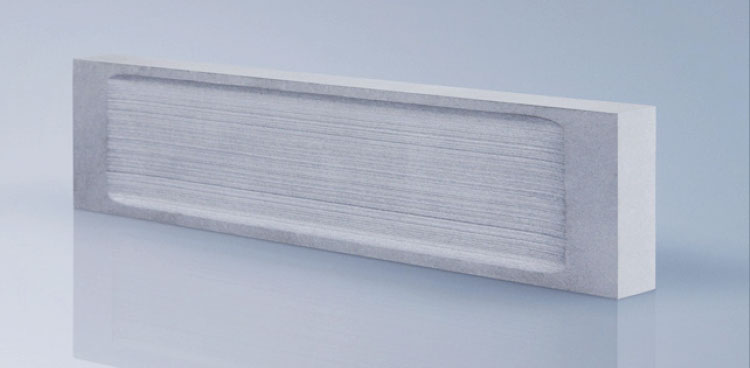Evaporation boats made of ceramic
Ceramic evaporation boats for metalization

Vacuum metallization with mixed-ceramic evaporation boats
In addition to visual properties, the barrier of a metalized substrate also changes in comparison to that of a pure substrate. This mainly affects the permeability of the substrate with regard to gases, fluids and electromagnetic radiation and is used for, among other things, food packaging. A crisp packet, for example, protects its contents from absorbing moisture and UV light and is also impermeable to fat and flavors.
Another application is in the area of electronics. Metallization makes it possible to simplify the manufacture of capacitor foils. In wafer coating, aluminum is used as the crystallization nucleus for zinc coatings, while zinc and silver coatings can likewise be protected against oxidation by using an aluminium coating. The housings of computers and smartphones are also often coated with metal layers that serve to shield the electronics from electromagnetic interference.
There are various processes available to carry out metallization. Besides chemical vapor deposition, cathode sputtering and electroplating, thermal evaporation of aluminum also plays an important role. It’s in this area where evaporation boats come into play. Metallization through this means in particular is characterized by high evaporation rates and good homogeneity of the vapor-deposited layer.
How evaporation boats work
Evaporation boats are ceramic components that act as receptacles for the metal (pure aluminum) to be evaporated. They function as electrical resistance heatersthe evaporation boat and a continuously fed aluminum wire are heated under high vacuum by current flow, so that the wire first melts and then evaporates. Due to special surface structuring and texture, a molten bath is formed and optimally distributed over the boat, thereby ensuring a homogeneous cloud of vapor. The metal vapor is then deposited on a substrate located above the vapor cloud.
Materials for evaporation boats
There are various requirements that evaporation boats must meet. For the principle of resistance heating to work, they must be electrically conductive; at the same time, they need a sufficiently high degree of electric resistance to make heating them possible at all. Furthermore, they must be resistant to high temperatures and inert towards molten metal. To combine these properties, mixed ceramics are made from two or three components.
Two-component evaporation boats contain titanium diboride and boron nitride. Due to its bonding structure, titanium diboride offers excellent resistance to high temperatures and remains inert even to non-ferrous metal melts. It also improves the wettability of the evaporation boat through liquid aluminum and ensures a melting bath with an extensive surface. For example, when used for aluminum vapor deposition, it’s completely wetted by liquid aluminum. In addition, titanium diboride is a very good electrical conductor. Boron nitride is added as a non-conductive material to set the electrical resistance of the evaporation boat.
Three-component mixed ceramics also include aluminum nitride. This material has very good thermal conductivity which makes it particularly suitable for large evaporation boats to ensure they heat up quickly and uniformly. Compared to two-component evaporation boats, the three-component versions have a shorter lifespan, with lower evaporation rates and less corrosion resistance. At the same time, the wettability of the evaporator is significantly improved and there’s greater homogeneity of the vapor-deposited layers. Three-component evaporators are therefore primarily used in the manufacture of capacitors, since this requires a particularly high level of homogeneity in the coatings.
Custom solutions/applications
The metallization process can be adapted quite flexibly to the requirements of the carrier material. Substrates that can be metalized include plastic or paper foils, and even plastic components. The thickness of the evaporated layer can also be adjusted during processing as required.

